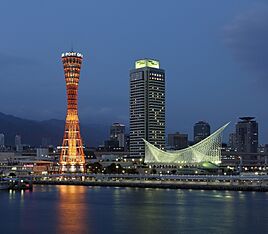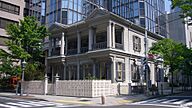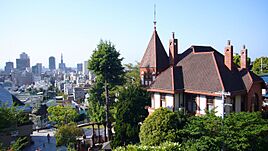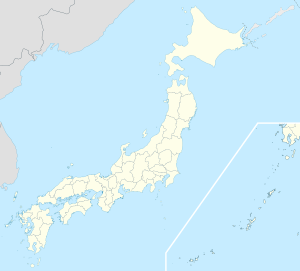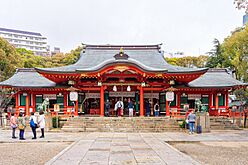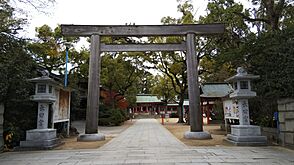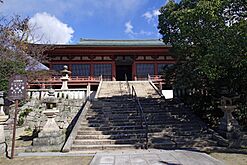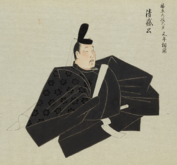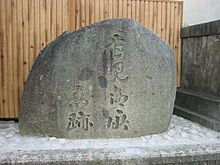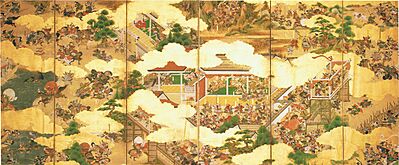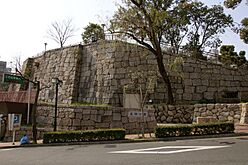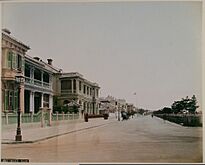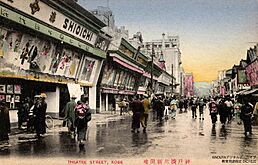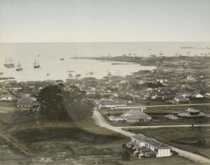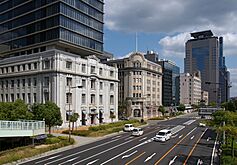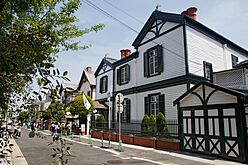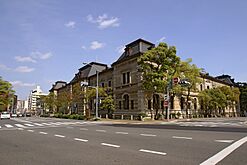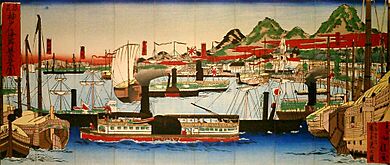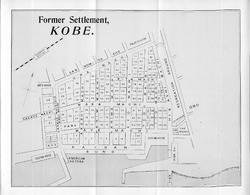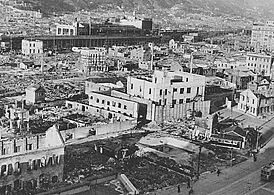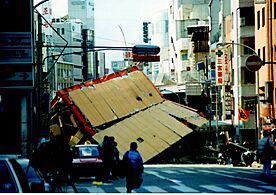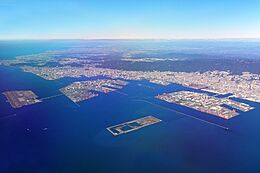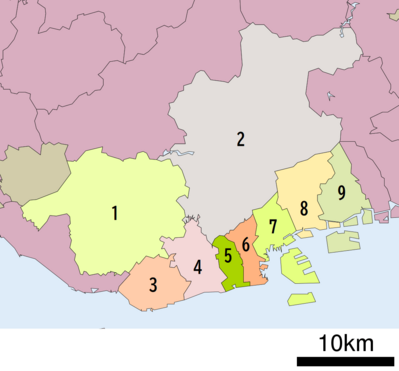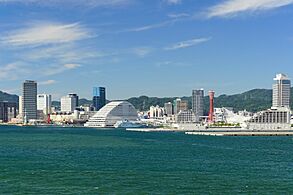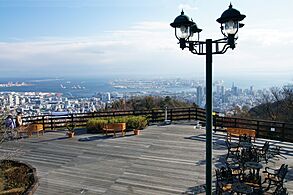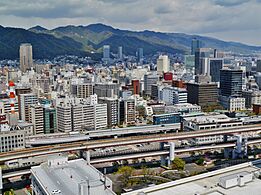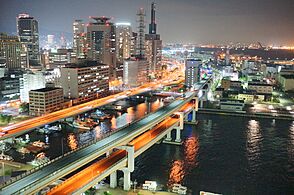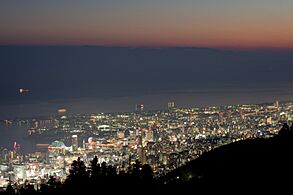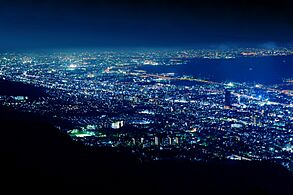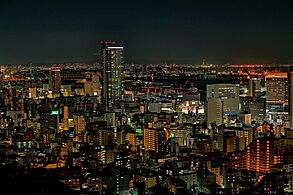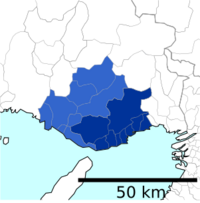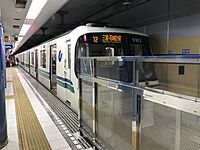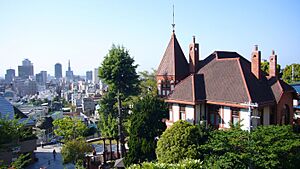Kobe facts for kids
Quick facts for kids
Kobe
神戸市
|
|||||||||||
|---|---|---|---|---|---|---|---|---|---|---|---|
| Kobe City | |||||||||||
|
From top left: Kobe Port Tower and Kobe Maritime Museum in Meriken Park, Old Kobe Residency 15th Hall (The Former American Consulate in Kobe) of the Kobe foreign settlement, Hyogo Prefectural Museum of Art, the Chinatown in Nankin-machi, Ikuta Shrine, and a view from Kobe Weathervane House (The Former Thomas House) of Kitano-cho
|
|||||||||||
|
|||||||||||
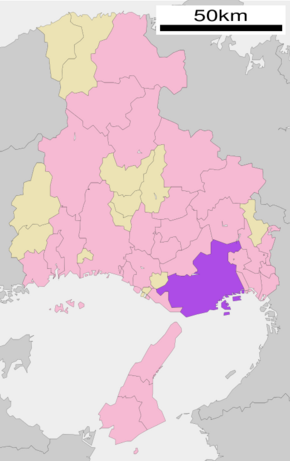
Location of Kobe in Hyōgo Prefecture
|
|||||||||||
| Country | Japan | ||||||||||
| Region | Kansai | ||||||||||
| Prefecture | Hyōgo Prefecture | ||||||||||
| First official record | 201 AD | ||||||||||
| City Status | April 1, 1889 | ||||||||||
| Area | |||||||||||
| • Designated city | 557.02 km2 (215.07 sq mi) | ||||||||||
| Population
(June 1, 2021)
|
|||||||||||
| • Designated city | 1,522,188 (7th) | ||||||||||
| • Metro
(2015)
|
2,419,973 (6th) | ||||||||||
| Time zone | UTC+9 (Japan Standard Time) | ||||||||||
| Phone number | 078-331-8181 | ||||||||||
| Address | 6-5-1 Kano-chō, Chūō-ku, Kōbe-shi, Hyōgo-ken 650-8570 |
||||||||||
| Climate | Cfa | ||||||||||
| Website | City of Kobe | ||||||||||
|
|||||||||||
| Kobe | |||||
|---|---|---|---|---|---|

|
|||||
| Japanese name | |||||
| Kyūjitai | 神戶 | ||||
| Shinjitai | 神戸 | ||||
|
|||||
Kobe (pronounced KOH-bay) is a big city in Japan. It's the capital of Hyōgo Prefecture. With about 1.5 million people, Kobe is Japan's seventh-largest city. It's also the third-largest port city, after Tokyo and Yokohama.
Kobe is located in the Kansai region on the main island of Honshū. It sits on the north shore of Osaka Bay. Kobe is part of a large city area called Keihanshin, which also includes Osaka and Kyoto. The city center of Kobe is about 35 kilometers west of Osaka. It is also about 70 kilometers southwest of Kyoto.
The first records of this area are from the year 201 AD. They mention the Ikuta Shrine. Kobe became a city in 1889. Its name comes from an old word, Kanbe. This word meant people who supported the Ikuta Shrine. In 1956, Kobe became a special "designated city" in Japan.
Kobe was one of the first cities to open for trade with Western countries in 1853. Because of this, it has a very diverse feel. You can see many old buildings from the Meiji era. Even though a big earthquake in 1995 affected its port, Kobe is still Japan's fourth-busiest container port. Many big companies have their main offices in Kobe. These include ASICS, Kawasaki Heavy Industries, and Kobe Steel. Over 100 international companies also have offices here.
Kobe is famous for its delicious Kobe beef. It is also home to Kobe University. You can find one of Japan's most famous hot spring resorts, Arima Onsen, nearby.
Contents
History of Kobe
Let's explore the history of Kobe, from ancient times to today.
Early Days: Ancient Kobe
Tools found in western Kobe show that people lived here a very long time ago. This was during the Jōmon period. The natural shape of the land helped a port grow. This port became important for the city's economy.
Some of the oldest writings mention the Ikuta Shrine. They say Empress Jingū founded it in 201 AD.
- Gallery
Medieval Times: Port Growth and Battles
During the Nara and Heian periods, the port was called Ōwada Anchorage. It was a key place for ships traveling to China. In 1180, Kobe was briefly the capital of Japan. This happened when Taira no Kiyomori moved the emperor here. But the emperor returned to Kyoto after about five months.
Later, in 1184, a big battle happened near the Ikuta Shrine. It was called the battle of Ichi-no-Tani. The Minamoto clan won this battle. As the port grew, it became known as Hyōgo Port. This was during the Kamakura period. It was a major trading hub with China.
- Gallery
-
Former location of Fukuhara-kyō
Edo Period: Divided Control
During the Edo period, different parts of Kobe were controlled by different rulers. The eastern parts were under the Amagasaki Domain. The western parts were under the Akashi Domain. The central area was directly controlled by the Tokugawa shogunate.
Kobe became a single political area in 1871. This was after the old system of domains ended.
- Gallery
Modern Kobe: Opening to the World
Hyōgo Port opened for foreign trade on January 1, 1868. This was just before the Meiji Restoration. There was some fighting in the area at this time. Soon after, the Kobe Incident happened. Western soldiers were injured by gunfire.
Kobe became known for its connections with the West. Many foreign homes from that time still stand in the Kitano area.
- Gallery
Kobe in Recent Times
Kobe was officially founded on April 1, 1889. During World War II, Kobe was bombed in 1942 and again in 1945. These bombings caused a lot of damage and many deaths. The famous Studio Ghibli film Grave of the Fireflies was inspired by these events.
In 1975, Kobe made a rule. It banned ships carrying nuclear weapons from its port. This rule, called the "Kobe formula," stopped U.S. warships from entering. This is because the U.S. does not say if its ships carry nuclear weapons.
On January 17, 1995, a strong earthquake hit Kobe. It was called the Great Hanshin earthquake. About 6,434 people died. Many homes and parts of the port were destroyed. The earthquake also damaged parts of the Hanshin Expressway. To remember the city's recovery, Kobe holds an event every December. It's called the Kobe Luminarie. The city center is decorated with beautiful lights.
Before the earthquake, the Port of Kobe was Japan's busiest port. It was also one of Asia's top ports. After the earthquake, its ranking dropped. But it is still an important port today.
- Gallery
Geography of Kobe
Kobe is a long, narrow city. It is located between the coast and mountains. To the east is Ashiya. To the west is Akashi. Other nearby cities include Takarazuka and Nishinomiya.
Landmarks and Islands
A famous landmark in the port area is the red Port Tower. You can also find a ferris wheel in Harborland. This is a popular place for tourists to walk around. Kobe has two man-made islands. They are called Port Island and Rokkō Island. These islands were built to give the city more space.
City Center and Mountains
The main areas in Kobe are Motomachi and Sannomiya. Kobe's Chinatown, Nankin-machi, is also a well-known shopping area. Many train lines cross the city. The main train station is Sannomiya Station.
Mount Rokkō is a mountain that overlooks Kobe. It is 931 meters tall. In autumn, its forests turn beautiful colors.
Wards of Kobe
Kobe is divided into nine areas called wards (ku). Each ward has its own unique features.
- Nishi-ku: This is the westernmost part of Kobe. It has the largest population.
- Kita-ku: This is the largest ward by area. It includes the Rokko Mountain Range. You can find Mount Rokkō and Mount Maya here. It's known for hiking trails and the Arima Onsen hot spring resort.
- Tarumi-ku: This is mostly a residential area. The Akashi Kaikyō Bridge, one of the world's longest suspension bridges, starts here.
- Suma-ku: This ward is home to Suma beach. Many visitors come here in the summer.
- Nagata-ku: This is where Nagata Shrine is located. It's one of Kobe's three "Great Shrines."
- Hyōgo-ku: This area is the historical heart of Kobe. It was once called Ōwada Anchorage or Hyōgo Port.
- Chūō-ku: Chūō means "central." This ward is the main business and entertainment area of Kobe. It includes Sannomiya, Motomachi, and Harborland. The city hall and Kobe Airport are also in this ward.
- Nada-ku: This ward is known for its sake production. It's also home to Oji Zoo and Kobe University.
- Higashinada-ku: This is the easternmost part of Kobe. The man-made Rokko island is in this ward.
| Wards of Kobe | ||||||
|---|---|---|---|---|---|---|
| Place Name | Map of Kobe | |||||
| Rōmaji | Kanji | Population | Land area in km2 | Pop. density
per km2 |
||
| 1 | Nishi-ku | 西区 | 240,386 | 138.01 | 1,742 | |
| 2 | Kita-ku | 北区 | 212,211 | 240.29 | 883 | |
| 3 | Tarumi-ku | 垂水区 | 216,337 | 28.11 | 7,696 | |
| 4 | Suma-ku | 須磨区 | 158,196 | 28.93 | 5,468 | |
| 5 | Nagata-ku | 長田区 | 95,155 | 11.36 | 8,376 | |
| 6 | Hyōgo-ku | 兵庫区 | 107,307 | 14.68 | 7,310 | |
| 7 | Chūō-ku | 中央区 | 142,232 | 28.97 | 4,910 | |
| 8 | Nada-ku | 灘区 | 136,865 | 32.66 | 4,191 | |
| 9 | Higashinada-ku | 東灘区 | 214,255 | 34.02 | 6,298 | |
Cityscape: Views of Kobe
- Gallery
-
Nunobiki Herb Garden (2012)
-
Kobe central business district (2018)
-
Kobe central business district at night (2016)
Kobe's Climate
Kobe has a humid subtropical climate. This means it has hot summers and cool to cold winters. It rains more in summer than in winter. But overall, it gets less snow than most parts of Japan.
The average yearly temperature in Kobe is 17.0°C (62.6°F). July is the wettest month. August is the hottest month, with an average of 28.6°C (83.5°F). January is the coldest, at about 6.2°C (43.2°F). The highest temperature ever recorded was 38.8°C (101.8°F) in 1994. The lowest was -7.2°C (19.0°F) in 1981.
| Climate data for Kobe (1991−2020 normals, extremes 1896−present) | |||||||||||||
|---|---|---|---|---|---|---|---|---|---|---|---|---|---|
| Month | Jan | Feb | Mar | Apr | May | Jun | Jul | Aug | Sep | Oct | Nov | Dec | Year |
| Record high °C (°F) | 19.2 (66.6) |
20.8 (69.4) |
23.7 (74.7) |
28.5 (83.3) |
31.9 (89.4) |
36.3 (97.3) |
37.7 (99.9) |
38.8 (101.8) |
35.8 (96.4) |
31.9 (89.4) |
26.2 (79.2) |
23.7 (74.7) |
38.8 (101.8) |
| Mean daily maximum °C (°F) | 9.4 (48.9) |
10.1 (50.2) |
13.5 (56.3) |
18.9 (66.0) |
23.6 (74.5) |
26.7 (80.1) |
30.4 (86.7) |
32.2 (90.0) |
28.8 (83.8) |
23.2 (73.8) |
17.5 (63.5) |
12.0 (53.6) |
20.5 (68.9) |
| Daily mean °C (°F) | 6.2 (43.2) |
6.5 (43.7) |
9.8 (49.6) |
15.0 (59.0) |
19.8 (67.6) |
23.4 (74.1) |
27.1 (80.8) |
28.6 (83.5) |
25.4 (77.7) |
19.8 (67.6) |
14.2 (57.6) |
8.8 (47.8) |
17.0 (62.6) |
| Mean daily minimum °C (°F) | 3.1 (37.6) |
3.4 (38.1) |
6.3 (43.3) |
11.4 (52.5) |
16.5 (61.7) |
20.6 (69.1) |
24.7 (76.5) |
26.1 (79.0) |
22.6 (72.7) |
16.7 (62.1) |
10.9 (51.6) |
5.7 (42.3) |
14.0 (57.2) |
| Record low °C (°F) | −6.4 (20.5) |
−7.2 (19.0) |
−5.0 (23.0) |
−0.6 (30.9) |
3.9 (39.0) |
10.0 (50.0) |
14.5 (58.1) |
16.1 (61.0) |
10.5 (50.9) |
5.3 (41.5) |
−0.2 (31.6) |
−4.3 (24.3) |
−7.2 (19.0) |
| Average precipitation mm (inches) | 38.4 (1.51) |
55.6 (2.19) |
94.2 (3.71) |
100.6 (3.96) |
134.7 (5.30) |
176.7 (6.96) |
187.9 (7.40) |
103.4 (4.07) |
157.2 (6.19) |
118.0 (4.65) |
62.4 (2.46) |
48.7 (1.92) |
1,277.8 (50.31) |
| Average snowfall cm (inches) | 0 (0) |
0 (0) |
0 (0) |
0 (0) |
0 (0) |
0 (0) |
0 (0) |
0 (0) |
0 (0) |
0 (0) |
0 (0) |
0 (0) |
1 (0.4) |
| Average precipitation days (≥ 0.5 mm) | 6.0 | 7.1 | 10.0 | 10.1 | 10.4 | 12.1 | 10.9 | 7.4 | 10.3 | 8.8 | 6.4 | 6.8 | 106.2 |
| Average relative humidity (%) | 62 | 61 | 61 | 61 | 64 | 72 | 74 | 71 | 67 | 64 | 63 | 62 | 65 |
| Mean monthly sunshine hours | 145.8 | 142.4 | 175.8 | 194.8 | 202.6 | 164.0 | 189.4 | 229.6 | 163.9 | 169.8 | 152.2 | 153.2 | 2,083.7 |
| Source: Japan Meteorological Agency | |||||||||||||
| Climate data for Kobe Airport (2006−2020 normals, extremes 2006−present) | |||||||||||||
|---|---|---|---|---|---|---|---|---|---|---|---|---|---|
| Month | Jan | Feb | Mar | Apr | May | Jun | Jul | Aug | Sep | Oct | Nov | Dec | Year |
| Record high °C (°F) | 17.2 (63.0) |
19.5 (67.1) |
21.3 (70.3) |
23.9 (75.0) |
30.2 (86.4) |
34.5 (94.1) |
36.2 (97.2) |
37.0 (98.6) |
35.2 (95.4) |
31.5 (88.7) |
24.3 (75.7) |
21.9 (71.4) |
37.0 (98.6) |
| Mean daily maximum °C (°F) | 9.3 (48.7) |
9.7 (49.5) |
12.8 (55.0) |
17.3 (63.1) |
22.2 (72.0) |
25.2 (77.4) |
28.6 (83.5) |
31.1 (88.0) |
28.1 (82.6) |
23.0 (73.4) |
17.3 (63.1) |
11.9 (53.4) |
19.7 (67.5) |
| Daily mean °C (°F) | 5.9 (42.6) |
6.3 (43.3) |
9.2 (48.6) |
13.7 (56.7) |
18.5 (65.3) |
22.2 (72.0) |
25.9 (78.6) |
27.9 (82.2) |
24.9 (76.8) |
19.7 (67.5) |
14.0 (57.2) |
8.5 (47.3) |
16.4 (61.5) |
| Mean daily minimum °C (°F) | 2.4 (36.3) |
2.6 (36.7) |
5.3 (41.5) |
9.9 (49.8) |
15.1 (59.2) |
19.8 (67.6) |
23.9 (75.0) |
25.6 (78.1) |
22.1 (71.8) |
16.7 (62.1) |
10.7 (51.3) |
5.1 (41.2) |
13.2 (55.8) |
| Record low °C (°F) | −3.6 (25.5) |
−3.4 (25.9) |
−1.5 (29.3) |
1.9 (35.4) |
7.0 (44.6) |
14.2 (57.6) |
19.4 (66.9) |
20.5 (68.9) |
14.7 (58.5) |
8.5 (47.3) |
2.7 (36.9) |
−1.4 (29.5) |
−3.6 (25.5) |
| Average precipitation mm (inches) | 33.3 (1.31) |
54.3 (2.14) |
83.2 (3.28) |
83.7 (3.30) |
117.6 (4.63) |
164.5 (6.48) |
186.9 (7.36) |
84.7 (3.33) |
135.1 (5.32) |
106.1 (4.18) |
52.8 (2.08) |
49.3 (1.94) |
1,148.4 (45.21) |
| Average precipitation days (≥ 1.0 mm) | 4.6 | 6.6 | 8.3 | 8.8 | 8.6 | 9.8 | 10.2 | 6.0 | 8.8 | 7.9 | 5.7 | 5.8 | 91.1 |
| Source: Japan Meteorological Agency | |||||||||||||
People of Kobe
| Foreigners in Kobe | |
| Nationality | Population (2018) |
|---|---|
| 17,175 | |
| 13,205 | |
| 5,955 | |
| 1,309 | |
| Others | 8,974 |
| Historical population | ||
|---|---|---|
| Year | Pop. | ±% |
| 1870 | 18,650 | — |
| 1880 | 48,786 | +161.6% |
| 1890 | 142,965 | +193.0% |
| 1900 | 283,839 | +98.5% |
| 1910 | 398,905 | +40.5% |
| 1920 | 746,500 | +87.1% |
| 1925 | 818,619 | +9.7% |
| 1930 | 915,234 | +11.8% |
| 1935 | 1,058,053 | +15.6% |
| 1940 | 1,134,458 | +7.2% |
| 1945 | 694,000 | −38.8% |
| 1950 | 821,062 | +18.3% |
| 1955 | 986,344 | +20.1% |
| 1960 | 1,113,977 | +12.9% |
| 1965 | 1,216,682 | +9.2% |
| 1970 | 1,288,930 | +5.9% |
| 1975 | 1,360,605 | +5.6% |
| 1980 | 1,367,390 | +0.5% |
| 1985 | 1,410,734 | +3.2% |
| 1990 | 1,477,410 | +4.7% |
| 1995 | 1,423,792 | −3.6% |
| 2000 | 1,493,398 | +4.9% |
| 2005 | 1,525,393 | +2.1% |
| 2010 | 1,544,873 | +1.3% |
| 2015 | 1,537,272 | −0.5% |
| 2020 | 1,521,241 | −1.0% |
As of September 2007, Kobe had about 1,530,295 people. This population lives in 658,876 homes. The city's population density is about 2,768 people per square kilometer. For every 100 females, there are about 90 males.
About 13% of the people are between 0 and 14 years old. About 67% are between 15 and 64 years old. And 20% are over 65 years old. Around 44,000 foreign people live in Kobe. The largest groups are from Korea, China, Vietnam, and America.
Kobe's Economy
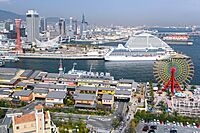
The Port of Kobe is a very important port. It is also a big manufacturing center. Kobe's port is the busiest container port in its region. It is the fourth-busiest in all of Japan.
In 2004, the city's total economic output was ¥6.3 trillion. This is a large part of the economy for Hyōgo Prefecture. About 1% of workers are in farming, fishing, and mining. 21% work in manufacturing and industry. The largest group, 78%, works in service jobs.
Kobe makes many different products. Small appliances, food, and transportation equipment are the biggest. These make up over half of Kobe's manufactured goods.
Companies and Research in Kobe
Many Japanese companies have their main offices in Kobe. These include ASICS (shoes), Kawasaki Heavy Industries (heavy machinery), and Kobe Steel. Other companies are Nestlé (food and drink) and Procter & Gamble (household goods).
Kobe is also home to important research centers. These include the RIKEN Kobe Institute Center. It focuses on biology and medical imaging. The National Institute of Information and Communications Technology is also here. It works on advanced communication technology.
International groups like the WHO Centre for Health Development are in Kobe too.
-
Procter & Gamble Asia headquarters on Rokko Island
-
Nestlé Japan Ltd. headquarters on Sannomiya
Getting Around Kobe

Kobe has many ways to travel, making it easy to get around.
Air Travel
For flights, you have a few choices. Itami Airport is nearby and mostly handles flights within Japan. Kobe Airport, built on an artificial island, also has mostly domestic flights. For international flights, people use Kansai International Airport in Osaka.
Train Travel
The JR West Sanyō Shinkansen (bullet train) stops at Shin-Kobe Station. Sannomiya Station is the main train hub in Kobe. From here, you can take trains to Osaka and Himeji. The Kōbe Electric Railway goes north to Sanda and Arima Onsen.
The Kobe Municipal Subway connects different parts of the city. There are also special train lines that go to Kobe Airport and Rokko Island.
Ropeways and Roads
Over Mount Rokkō, Kobe has funiculars and aerial lifts. These are like cable cars that take you up the mountain.
Kobe is also a major hub for expressways. These include the Meishin Expressway and the Hanshin Expressway. The Kobe-Awaji-Naruto Expressway connects Kobe to Naruto. This road includes the Akashi Kaikyō Bridge, which is the longest suspension bridge in the world.
Sea Travel
The Port of Kobe is one of Japan's busiest ports for shipping containers.
Education in Kobe
Kobe has many schools for students of all ages. The city manages 169 elementary schools and 81 middle schools. These schools teach about 80,200 elementary students and 36,000 middle school students. There are also private schools in the city.
Kobe also has 25 public high schools. Six of these are managed by the city itself. The rest are managed by the Hyogo Prefectural Board of Education. There are also 25 private high schools. In total, about 43,400 students attend high school in Kobe.
The city is home to 18 universities, including Kobe University. There are also 8 junior colleges. Many international students come to Kobe to study Japanese. There are 17 Japanese language schools for them.
Kobe also has international schools. These schools teach in English, German, Chinese, and Korean. They are for foreign families living in Kobe.
Culture and Fun in Kobe
Kobe is famous for its delicious Kobe beef. It's also known for Arima Onsen, a popular hot spring resort. Important buildings include the Ikuta Shrine and the Kobe Port Tower. The nearby mountains, Mount Rokkō and Mount Maya, offer great views of the city.
Kobe is seen as a very stylish and international city. People in Japan sometimes say, "If you can't go to Paris, go to Kobe." The city hosts a fashion event called Kobe Fashion Week. It also has a jazz festival called "Kobe Jazz Street" every October.
Kobe has Japan's first golf course, the Kobe Golf Club, built in 1903. It also has Japan's first mosque, built in 1935. You can visit the Kobe City Museum and the Museum of Literature. Many old Western-style homes from the 1800s can still be seen in the Kitano area.
The local way of speaking in Kobe is called Kobe-ben. It's a type of Kansai dialect.
Sports in Kobe
| Club | Sport | League | Venue | Established |
|---|---|---|---|---|
| Orix Buffaloes | Baseball | Pacific League | Kobe Sports Park Baseball Stadium Osaka Dome |
1938 |
| Vissel Kobe | Football | J. League | Noevir Stadium Kobe Kobe Universiade Memorial Stadium |
1995 |
| INAC Kobe Leonessa | Football | L. League | Noevir Stadium Kobe Kobe Universiade Memorial Stadium |
2001 |
| Deução Kobe | Futsal | F. League | World Hall | 1993 |
| Kobelco Steelers | Rugby | Top League | Noevir Stadium Kobe Kobe Universiade Memorial Stadium |
1928 |
| Hisamitsu Springs | Volleyball | V.Premier League | 1948 |
Kobe has hosted many sports events. It held the 1985 Summer Universiade, which is like a mini-Olympics for university athletes. It also hosted the 1991 ABC Championship for men's basketball.
Kobe was one of the cities for the 2002 FIFA World Cup. Matches were played at Kobe City Misaki Park Stadium. The city also hosted the 2006 Women's Volleyball World Championship. In 2017, Kobe hosted the World Darts Federation World Cup.
Kobe's International Friends
Kobe has many "sister cities" around the world. These are cities that have special friendly relationships.
Sister cities
Friendship and cooperation cities Kobe also works with other cities in friendship and cooperation:
 Daegu, South Korea (2010)
Daegu, South Korea (2010) Faisalabad, Pakistan (2000)
Faisalabad, Pakistan (2000) Kigali, Rwanda (2016)
Kigali, Rwanda (2016) Philadelphia, United States (1986)
Philadelphia, United States (1986)
Kobe also has "sister ports" for its harbor. Sister ports
Images for kids
-
Kobe Oji Zoo as home of the giant and red pandas
See also
 In Spanish: Kōbe para niños
In Spanish: Kōbe para niños


